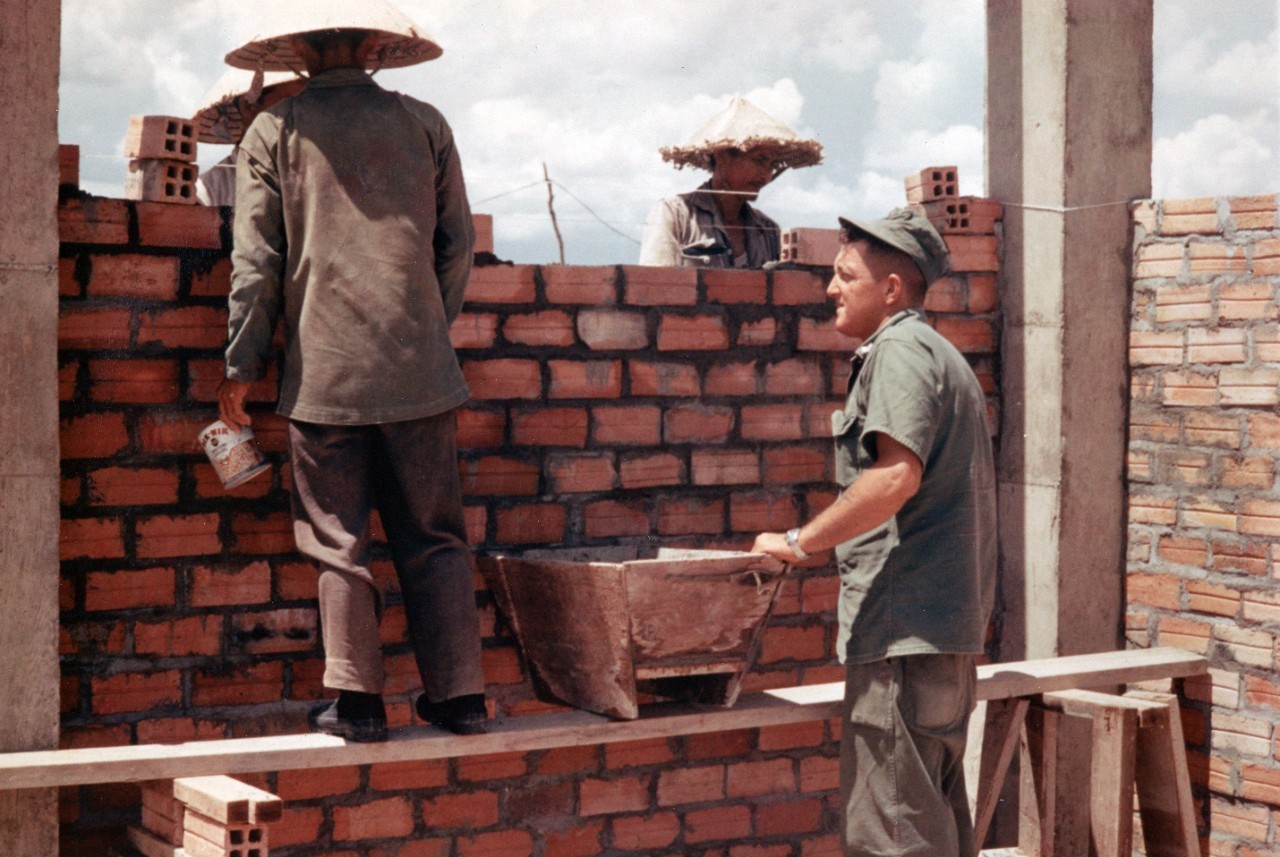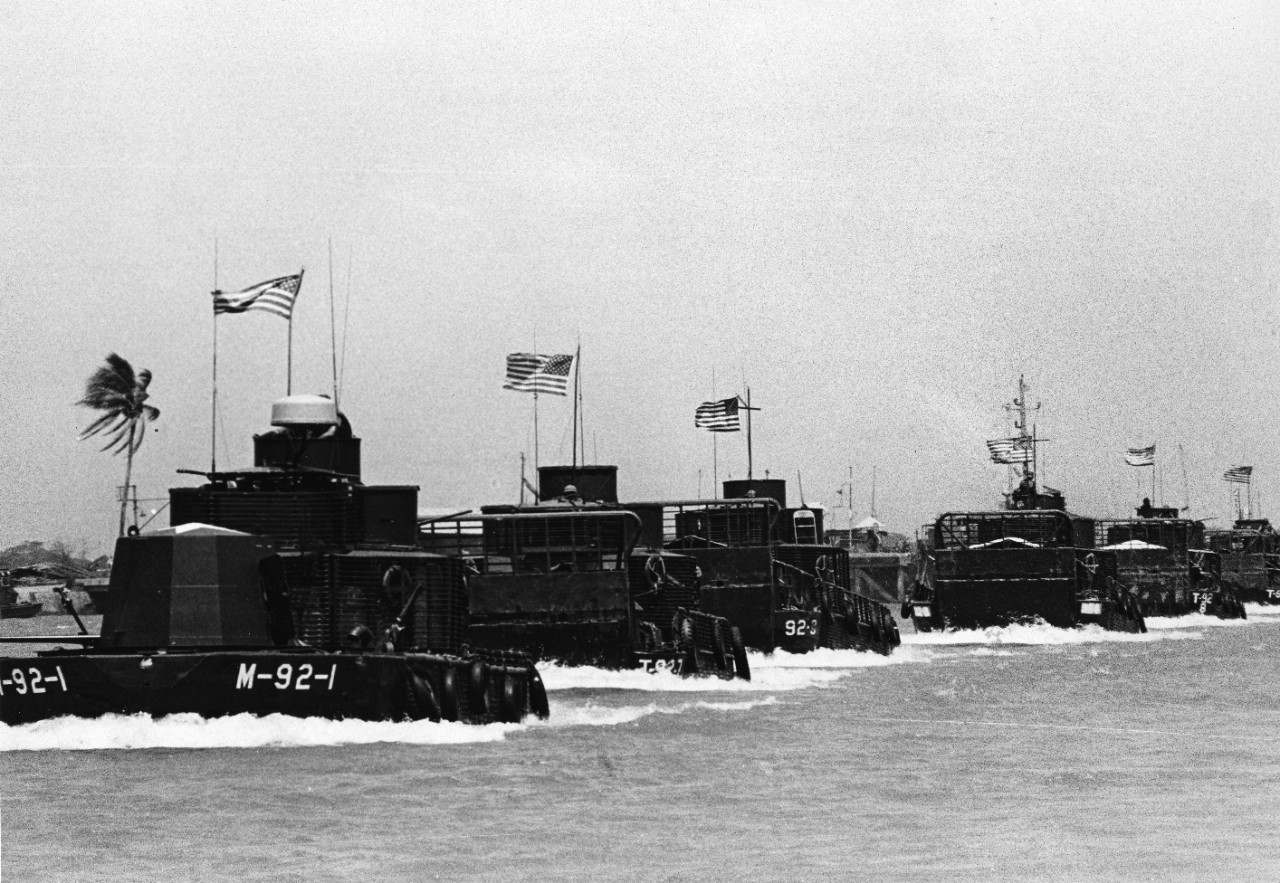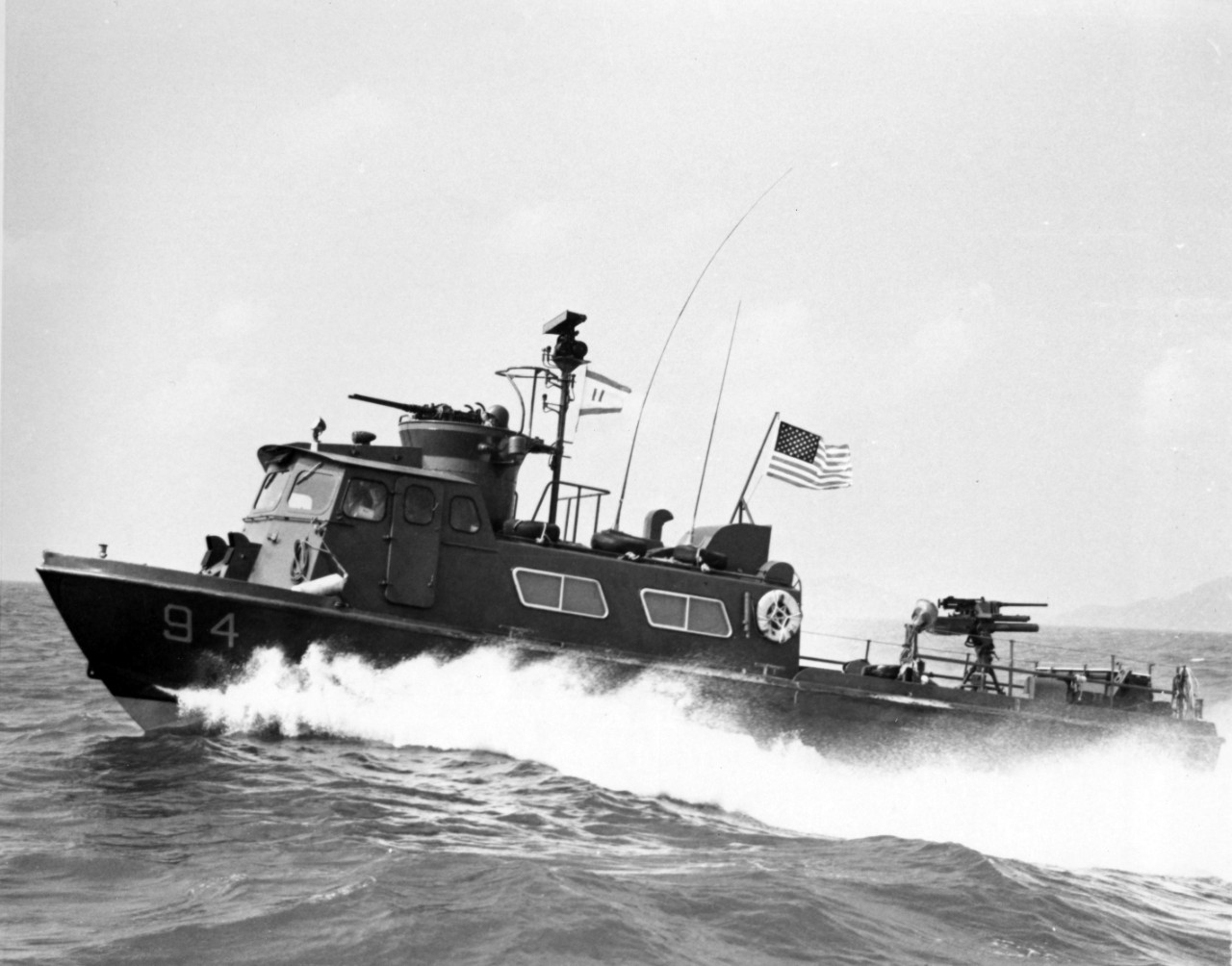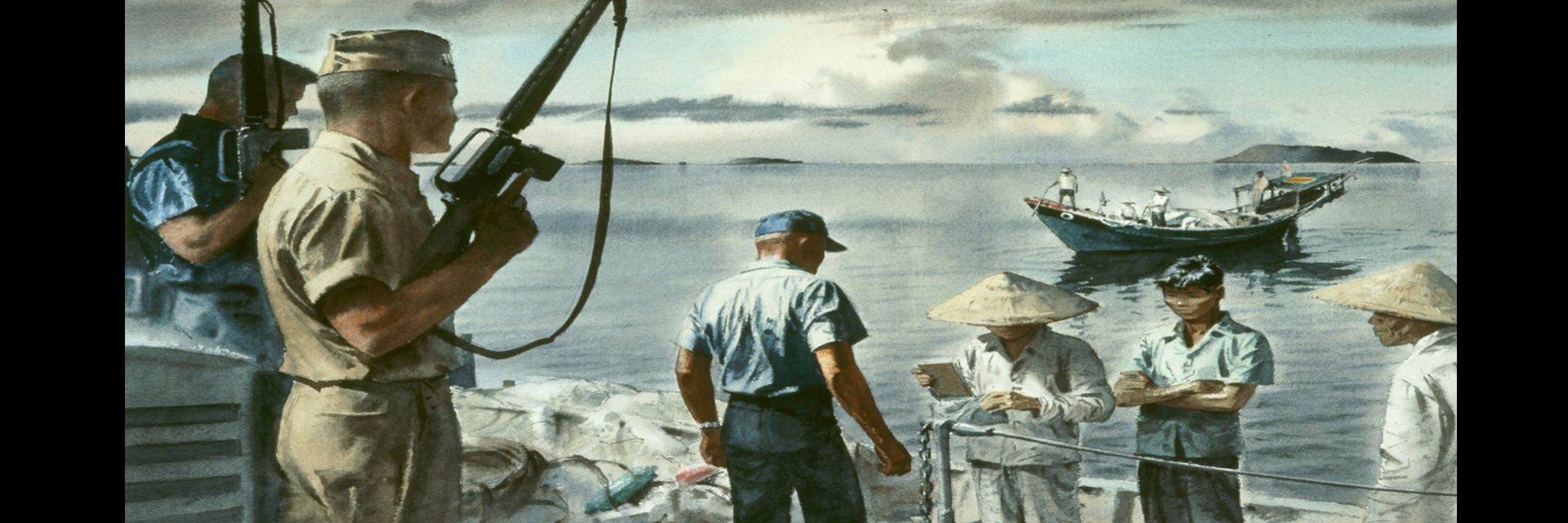With effective new weapons and tactics, the U.S. Navy pulled out all the stops to deny the communist insurgents control of Vietnam’s rivers and coastline.
◊
There were a lot of “firsts” in the Vietnam War, including it being the first war Americans watched from the comfort of their living rooms on the nightly TV news. Less familiar to most of the public was the return to river warfare, a type of combat not witnessed since the Civil War. Though the U.S. Navy developed a class of river patrol boats to ply the rivers of the volatile Chinese mainland in the 1920s and ’30s, there were no naval engagements. Only the aerial bombing of USS Panay by the Japanese in 1937 challenged the river calm – and it said more about the future of naval aerial warfare than it did about the role of river patrols.
For a time, it seemed the Republic of Vietnam’s navy (VNN) would be able to keep the country’s waterways intact using vessels left behind by the French after the spectacular failure of that colonial power to hold onto its Indochina colonies. But communist insurgents, the Viet Cong, began infiltrating all areas of the country.
The perspective of the West was expressed by President Dwight D. Eisenhower, who believed the communists would follow up their conquest of the northern part of Vietnam with invasions of the rest of Indochina, and even Indonesia and the Philippines. Following the formation of the Southeast Asia Treaty Organization (SEATO) with the United Kingdom, Australia, and other allies, the U.S. began sending military advisors to South Vietnam to assist the country’s armed forces, including the VNN.
To learn more about river warfare in Vietnam, watch Episode 1 of MagellanTV’s The Vietnam War.
The Escalation to a Full-Scale War in Vietnam
Attacks on U.S. military advisors and other incidents led the United States to fully commit to the conflict in 1965. This encompassed all types of American forces. One priority was to stem North Vietnam’s ability to supply the Viet Cong via coastal shipping. To accomplish this goal, the U.S. launched Operation Market Time. Using planes and smaller naval craft such as minesweepers, destroyer escorts, U.S. Coast Guard cutters, and patrol boats, the operation squeezed off the coastal route for weapons, munitions. and war supplies from the north. Among these novel boats were the high speed and well armed Fast Patrol Craft (FPC), or “Swift Boats.”
CALLOUT: Military Assistance Command, Vietnam (MACV) was the American military command structure overseeing U.S. efforts in Vietnam. It encompassed all U.S. forces, and a number of commands spanned all service branches under it.
North Vietnam had to find other ways to supply the Viet Cong – and eventually its own troops – in the south. One method was to truck supplies down a long trail through Laos. The other was to bring supplies through the Mekong Delta and, later, to the river port of Sihanoukville, near the South Vietnam border, in self-proclaimed neutral Cambodia.

Mekong Delta in South Vietnam (Credit: Naval History and Heritage Command)
This immediately brought the vast delta of the Mekong River and its countless tributaries to the center of attention. The Mekong is the third longest river in Asia, originating in the Tibetan highlands and flowing more than 3,000 miles through China, Myanmar, Thailand, Laos, Cambodia, and Vietnam. The rapids and falls on the river make navigation treacherous through most of its length. However, the Mekong Delta can accommodate small merchant vessels and many other types of watercraft. The new route through the delta became a vital lifeline of munitions support for many enemy operations in and against South Vietnam.
Not only was the Mekong Delta’s river system the new supply route for the Viet Cong, it was also a vast web of activity supporting all of the insurgent group’s activities. The area was a source of recruits; it provided space for training centers, weapons warehousing, hospitals, and command centers. The delta was the breadbasket of the Republic of Vietnam’s southern section. The waterways connecting the delta with Saigon, the country’s capital, largest city, and major port, provided opportunities for the Viet Cong to interrupt food supplies to the capital.
Patrolling the Mekong Delta
If the Viet Cong were going to control the waterways of the region vital to their operations, they would have to fight in the open. MACV quickly responded to the situation in the Mekong Delta. On December 18, 1965, the U.S. established the River Patrol Force and the “brown water navy” was born. Early the following year, the first deployment of the brown water navy into the Mekong’s Rung Sat swamp proved the success of the strategy. The combined operation of the U.S. Navy and Marines, along with South Vietnamese forces, showed how the force could destroy enemy bases and supplies in the region.
The early success led to an operation called Game Warden on the Mekong and Bassac rivers, and their main tributaries, with a mission to stop the Viet Cong’s raiding of commercial ships, to disrupt the insurgents’ use of the waterways, and to allow the South Vietnamese government to maintain control of the people and resources of the region. The basic complement of the campaign was a two-boat random patrol using a newly designed and built craft, the Patrol River Boat (PBR). With design ideas borrowed from pleasure craft, the 31-foot PBR was constructed of fiberglass, which made it resistant to the destructive marine life of Vietnam’s rivers. Its principle armament was twin .50 caliber machine guns. The PBR could achieve a top speed of 20 knots.
The patrols would stop suspicious river traffic with orders to board, inspect, and take further action if necessary. A dusk-to-dawn curfew imposed by the South Vietnamese government made nighttime operations challenging, because local farmers and fishermen would often violate it.
In addition, the Viet Cong were able to mine the rivers with explosive devices that could be detonated by soldiers hiding in the jungle thicket when vessels approached. For this reason the U.S. Navy deployed a series of mine sweeping craft that could navigate the delta’s waterways. And Navy helicopters were located at Mekong Delta bases to support the firefights that would occur when insurgent boats fled or patrols ran into Viet Cong ambushes.
One example of how a simple patrol sweep could escalate into a major action occurred on October 31, 1966, near My Tho. Boatswain’s Mate 1st Class James S. Williams was in command of a PBR patrol when he encountered a sampan (a small and narrow boat common in the area) that opened fire on his boats. The retreating sampan led Williams into a nest of hostile junks and other vessels loaded with Viet Cong soldiers.
Undeterred by the enemy’s numbers, Williams charged his two PBRs through the channel of boats, breaking up the flimsy craft and throwing soldiers into the water. He called for air support, but, before helicopters arrived, he reversed the direction of his boats and charged back toward the point of entry to the tributary, with the same destructive effect. His boat was still engaged as the Huey helicopters arrived to attack the congregation of Viet Cong vessels.
The Viet Cong lost many boats and soldiers in the three-hour action. For exceptional bravery in this engagement, Williams received the Congressional Medal of Honor from President Lyndon B. Johnson.

PBR sailors and Navy SeeBees helped bring humanitarian aid and assistance to the villagers of the Mekong Delta in Operation Handclasp. (Credit: Naval History and Heritage Command)
The PBRs and minesweepers were joined by an increasing number of other Navy and Coast Guard vessels such as armored troop carriers (ATC), armored support patrol boats (ASPB), and monitors in preparation for increased offensive activity in the delta. The weapons were also varied and ingenious: fire arrows and flame throwers to burn out sampans and junks, as well as water cannons to eradicate Viet Cong coastal enclaves.
Mobile Riverine Force
Though Operation Game Warden to interdict supplies and infiltrators was having success, General William C. Westmoreland, MACV commander, determined the riverine force needed an assault element to fight the increasing number of Viet Cong guerrilla units in the Mekong Delta. The Marines were occupied in the northern part of the country, so elements of the U.S. Army’s 9th Infantry Division joined the “river rats” of the Navy to form assault units.

A line of monitors and ATCs on the Mekong River Canal (Credit: Naval History and Heritage Command)
The river patrols had generally been operating from floating bases, usually LSTs (a familiar World War II-era support ship). Now, new types of customized floating bases were delivered to Vietnam. In late 1967, a large base was built at Dong Tam near My Tho. But the demands on the U.S. Navy patrol vessels were about to increase.
The Marines were battling an increasing number of soldiers from the North Vietnamese Army just south of the demilitarized zone (DMZ) at the 17th parallel. The Marine Corps commander requested that the patrol boats protect river convoys between the Navy support base at Danang and the front lines.
All these preparations and deployments were timely. At the end of January 1968, the largest offensive of the war was launched by the Viet Cong and North Vietnamese Army during the Tet religious holiday. The offensive targeted cities throughout all regions. The Communists’ strategy was to shield its soldiers with civilians living in the cities they took. That meant house-to-house fighting for the American, Allied, and South Vietnamese forces. The riverine fighters were engaged in many of these battles, and the many Allied counterattacks dissolved the gains of the Tet offensive of 1968.
Change of Command
In 1968, General Creighton W. Abrams replaced Westmoreland as MACV commander; Vice Admiral Elmo R. Zumwalt, Jr. assumed command of all naval operations in Vietnam. The coastal and river patrol forces had been very successful, leading the North Vietnamese to begin a new supply strategy: shipping war materials to the Cambodian port of Sihanoukville, and then transporting them across the border by way of small canals and waterways along the Vietnam-Cambodia border.
Zumwalt developed a strategy to blockade the Gulf of Siam and at the same time increase the activities of the mobile riverine force to interdict the supplies coming from Sihanoukville. His SEALORDS program stood for Southeast Asia Lake, Ocean, River, Delta Strategy.
Part of the program was to bring Swift Boats to the delta region to increase patrols and deployments. With a top speed of 23–25 knots, .50 caliber machine guns, and 88-millimeter mortars, the PCFs could land forces quickly and protect the amphibious landings with their armament. They joined the PBRs and other veteran riverine boats in a ferocious struggle for control of the delta supply routes and enemy enclaves.

U.S. Navy PCF "Swift Boat" on patrol in the Gulf of Thailand, March 1968 (Credit: Naval History and Heritage Command)
There were many hot fights in the region in which Swift Boats and other riverine craft landed U.S. Army troops, South Vietnamese Army (ARVN) soldiers, and South Vietnamese Marines. The battles in the Mekong Delta were tilting the balance while heavy fighting continued elsewhere in Vietnam, resulting in the 1970 invasion of Cambodia, which aimed to prevent that country’s Khmer Rouge from aiding North Vietnam and the Viet Cong.
From that point on, a momentous change in U.S. policy would dictate the river war’s future: “Vietnamization,” the turnover of all military activities to the Republic of South Vietnam. This mission was conducted gradually through 1973’s official pullout of U.S. forces – forces that had fought bravely and paid dearly in blood for their accomplishments.
Although many Americans struggle with the idea that any aspect of the Vietnam War could be considered successful, much less a victory, the U.S. riverine force and related operations in Vietnam’s coastal and inland waterways were, from a military perspective, successfully executed. These campaigns were then passed on to the South Vietnamese Navy, which managed to continue operations and largely maintain control of the waterways. They were not responsible for the war’s outcome.
Rather, the end came after massive attacks in a North Vietnamese ground offensive in the north and central parts of the country, which ultimately led to the collapse of the Republic of Vietnam in 1975. The rest, as they say, is military history.
Ω
Jay Wertz is an award-winning author, publisher, and filmmaker. He has written seven books, including four volumes in the War Stories: World War II Firsthand™ series. Other books include The Native American Experience; The Civil War Experience 1861–1865; and Smithsonian’s Great Battles and Battlefields of the Civil War, co-authored with Edwin C. Bearss. He is the editor and a primary contributor to D-Day 75th Anniversary – A Millennials Guide and other works for Monroe Publications. He has been a columnist and online contributor for Civil War Times Illustrated, America’s Civil War, Aviation History, Armchair General, and America in WWII magazines. He is also the producer-director-writer of the documentary series Smithsonian’s Great Battles of the Civil War for The Learning Channel and Time-Life Video.
Title Image: Operation Market Time, watercolor by Gene Klebe, 1965 (Credit: Naval History and Heritage Command)


